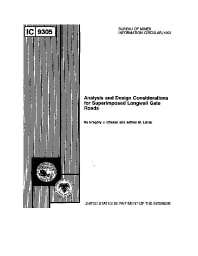Mining Publication: Analysis and Design Considerations for Superimposed Longwall Gate Roads
Original creation date: January 1992
Authors: GJ Chekan, JM Listak
NIOSHTIC2 Number: 10011183
U.S. Department of the Interior, Bureau of Mines, Information Circular 9305, 1992 Jan:1-14
The U.S. Bureau of Mines is investigating longwall panel layouts to maximize coal recovery and minimize interactive problems in multiple-seam operations. When coalbeds are longwall-mined in descending order, the transfer of stress from overlying gate roads is a major design constraint affecting pillar stability in the lower mine. The lower mine gate road pillars must be properly designed to withstand the additional load transfer if gate roads are superpositioned in successive seams. The Bureau's MULSIM/NL model, a boundary element computer program, was used to analyze load transfer mechanics for superpositioned gate road pillars. Analysis of longwall pillar stability (ALPS), an empirically based design method for longwall gate road pillars, was used to calibrate model input parameters. ALPS provided a basis to verify model trends and to recommend limits for safe pillar design when superpositioning longwall gate roads. The attributes of the MULSIM/NL model and ALPS were combined to develop a modified method for estimating pillar stress for multiple-seam cases. The modified method uses a multiple-seam factor (MS) to estimate the stress on superpositioned lower mine gate road pillars. Numerical analysis shows that MS depends on the interburden thickness and pillar width.

NIOSHTIC2 Number: 10011183
U.S. Department of the Interior, Bureau of Mines, Information Circular 9305, 1992 Jan:1-14